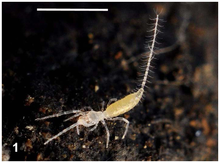Palpigradi
| Palpigradi Temporal range: Cenomanian–Recent |
|
|---|---|
 |
|
| Eukoenenia spelaea | |
| Scientific classification | |
| Kingdom: | Animalia |
| Phylum: | Arthropoda |
| Class: | Arachnida |
| Order: |
Palpigradi Thorell, 1900 |
| Families & genera | |
|
|
A palpigrade, commonly known as a microwhip scorpion, is an invertebrate animal belonging to the order Palpigradi in the class Arachnida, in the subphylum Chelicerata of the phylum Arthropoda.
Palpigrades belong to the arachnid class. They are tiny cousins of the uropygids, or whip scorpions, no more than 3 millimetres (0.12 in) in length, and averaging 1–1.5 mm (0.04–0.06 in). They have a thin, pale, segmented integument, and a segmented abdomen that terminates in a whip-like flagellum. This is made up of 15 segment-like parts, or "articles", and may make up as much as half the animal's length. Each article of the flagellum bears bristles, giving the whole flagellum the appearance of a bottle brush. The carapace is divided into two plates between the third and fourth leg pair of legs. They have no eyes.
As in some other arachnids, the first pair of legs is modified to serve as sensory organs, and are held clear of the ground while walking. Unusually, however, palpigrades use their pedipalps for locomotion, so that the animal appears to be walking on five pairs of legs.
Some palpigrades have three pairs of abdominal lung-sacs, although these are not true book lungs as there is no trace of the characteristic leaflike lamellae which defines book lungs. However, many species have no respiratory organs at all and breathe directly through the cuticle.
Species of Palpigradi live interstitially in wet tropical and subtropical soils. A few species have been found in shallow coral sands and on tropical beaches. In Europe, they have been found in caves and underground spaces. There is one endemic species on the island of Malta, in the Mediterranean Sea, which exists only in one specific cave. They need a damp environment to survive, and they always hide from light, so they are commonly found in the moist earth under buried stones and rocks. They can be found on every continent, except in Arctic and Antarctic regions. Terrestrial Palpigradi have hydrophobic cuticles, but littoral (beach-dwelling) species are able to pass through the water surface easily.
...
Wikipedia
